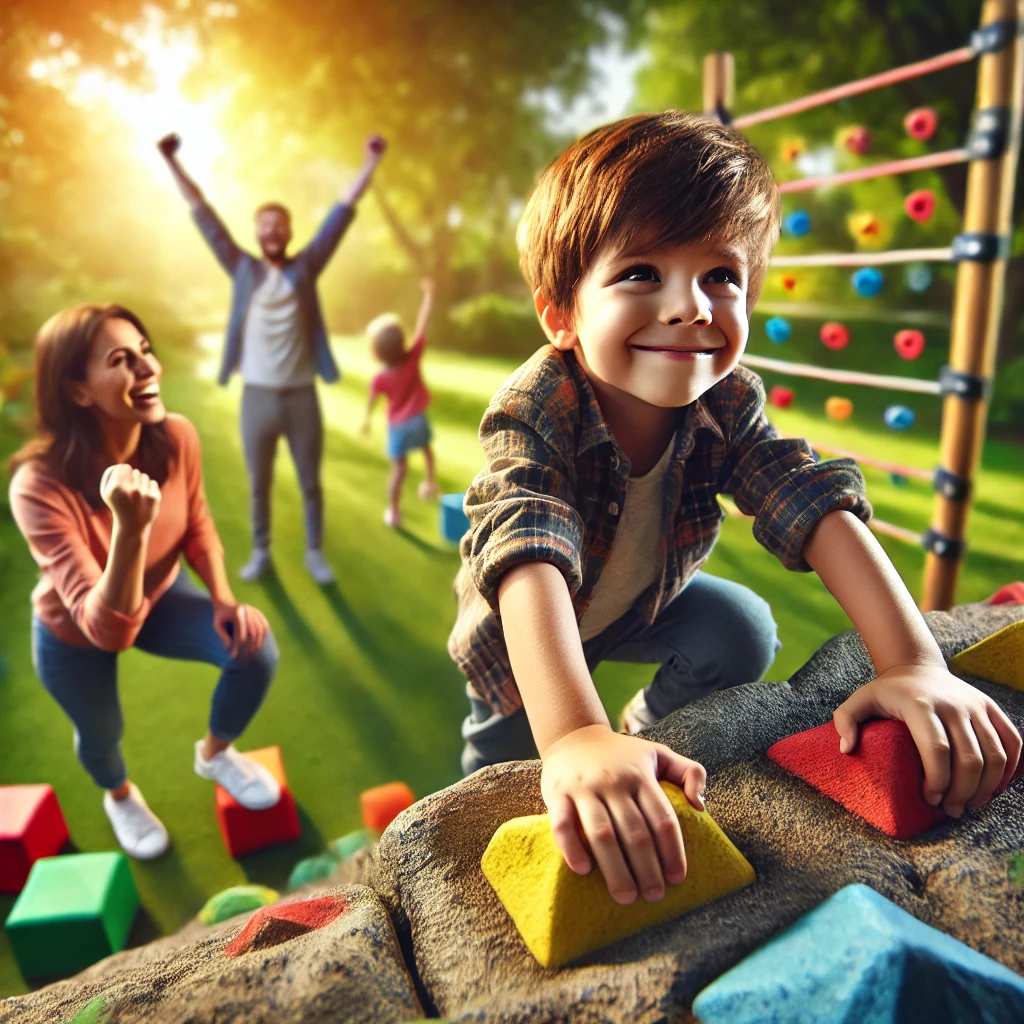Every adult has experienced the fear of failure at some point in their lives—it’s a natural part of growing and learning. But as parents, we all want to guide our children to rise above this fear, empowering them to unlock their full potential.
Here’s the exciting news: modern neuroscience has revealed powerful insights into how we can help children conquer the fear of failure. These strategies aren’t just developmentally positive—they’re truly life-changing. 🧠✨
Thanks to groundbreaking research, we now have tools to help children reframe failure as an opportunity for growth, rather than a setback. By fostering confidence and resilience, we can empower our kids to embrace challenges and approach life with courage and optimism. 💪🌈

In this article, we’ll explore the science behind the fear of failure and why reframing mistakes is a crucial part of your child’s development. We’ll also introduce some cutting-edge, science-backed practices that any parent can use to help their child overcome challenges, build natural confidence, and develop the skills they need to thrive in life.
If this sounds good to you, please read on! 🌟🌈✨
🌈 What Your Child Gains by Learning These Skills
Fear of failure doesn’t just affect kids in the moment—it can hold them back in school, relationships, and life. By teaching them to see mistakes as opportunities, you’re giving them tools to thrive and grow with confidence.

1️⃣ Builds Emotional Resilience 🌱
Kids learn to bounce back stronger after setbacks.
Example:
A child who spills their milk learns to clean it up and try again, instead of getting upset or discouraged.
2️⃣ Fosters Problem-Solving Skills 🧩
Mistakes encourage critical thinking and adaptability.
Example:
When a child’s block tower collapses, they ask, “How can I make it sturdier next time?”
3️⃣ Encourages Perseverance 🎓
Reframing failure helps kids persist through challenges and setbacks.
Example:
A student who doesn’t pass a test learns to study differently or seek help, rather than giving up entirely.
4️⃣ Improves Social Skills 🤝
Handling mistakes with grace builds empathy, confidence, and better interactions in group settings.
Example:
A child who loses a game says, “I’ll practice and get better!” instead of withdrawing or feeling defeated.
The Science That Backs It Up 🧠
Cutting-edge research reveals why reframing failure is so transformative for children. These principles offer practical ways to help kids overcome the fear of failure and grow with confidence:

1️⃣ Predictive Processing: Learning Through Feedback 🔄
How It Works:
The brain learns by predicting outcomes and adjusting based on feedback. Mistakes provide valuable data for refining these predictions.
Example:
A child learning to ride a bike falls but realises they need to balance better next time.
How It Helps:
Viewing failure as feedback reduces fear by making mistakes a natural part of the learning process.
Parent Tip:
Say, “Every time you try, you’re getting closer to figuring it out!”
2️⃣ Growth Mindset : The Power of Effort 🌱
How It Works:
Dr. Carol Dweck’s research shows that praising effort over results encourages persistence and a love for challenges.
Example:
After a tough puzzle, saying, “You worked so hard on that!” helps your child focus on their determination, not the outcome.
How It Helps:
A growth mindset shifts the narrative from “I can’t do this” to “I’m learning how to do this.”
Parent Tip:
Use phrases like, “What did you learn?” to focus on growth rather than perfection.
3️⃣ Zone of Proximal Development (ZPD): Gradual Growth 🚀
How It Works:
Lev Vygotsky’s ZPD explains that kids thrive when challenges are slightly beyond their current abilities, with support to bridge the gap.
Example:
A child hesitant to read aloud gains confidence by practicing with a parent before presenting to the class.
How It Helps:
Incremental steps reduce anxiety and build skills, ensuring steady progress without overwhelming the child.
Parent Tip:
Break tasks into small, manageable steps to encourage gradual, consistent growth.
4️⃣ Relevance Realization : Connecting Failures to Growth 🧩
How It Works:
Kids learn best when they see how mistakes contribute to meaningful goals.
Example:
Falling during gymnastics practice helps a child adjust their movements and improve their routine.
How It Helps:
Connecting failures to tangible progress helps kids view mistakes as valuable steps toward success.
Parent Tip:
Say, “What did this mistake teach you about reaching your goal?”
Now That We Understand the Science 🧠✨

We’ve seen how both children’s and adults’ brains act as prediction machines, constantly learning and adapting through feedback. When children engage in tasks slightly beyond their current skill level, supported by positive reinforcement and the ability to keep trying, their brains thrive.
Now, let’s explore a science-backed practice that combines all these insights into an engaging, practical tool to help children overcome their fear of failure and develop confidence.
Introducing the “Mistakes-to-Mastery” Game 🎮
The “Mistakes-to-Mastery” Game is a fun, science-backed activity designed to help children embrace mistakes as opportunities for growth. It incorporates cutting-edge insights from neuroscience and psychology, combining Predictive Processing, Growth Mindset, and the Zone of Proximal Development into a simple and engaging process.

Step 1: Create a Fun, Skill-Based Challenge 🎯

What to Do:
Choose an activity that is slightly challenging and taps into their interests or current goals. Examples for this age group include:
- Building a tall LEGO structure 🏗️.
- Solving a medium-level puzzle 🧩.
- Trying a new trick on a scooter or bike 🚴.
- Practicing a tricky spelling word or math problem ✏️.
Why It Works:
Older kids are more motivated when the task feels meaningful and connected to their interests. This approach encourages engagement and effort.
Key Tip:
Say, “This is meant to be a little tricky—that’s how we learn. Let’s see what you can figure out!”
Step 2: Reflect on Mistakes Together 🔍

What to Do:
Encourage your child to pause after each attempt and reflect on what worked, what didn’t, and how they might improve.
Why It Works:
At this age, kids can start thinking critically about their actions. This reflection process empowers them to approach problems logically and learn from mistakes.
Key Tip:
Use open-ended questions like:
- “What do you think went wrong?”
- “What’s one thing you might do differently next time?”
Keep it positive: “That’s a great idea—let’s try it!”
Step 3: Celebrate Effort and Progress 🎉

What to Do:
Acknowledge their hard work and improvement, focusing on how much they’ve learned or how they persisted through the challenge.
Why It Works:
Celebrating effort helps them connect the dots between persistence and growth, reinforcing the idea that trying leads to progress.
Key Tip:
Say, “Look how much better you got after a few tries—great job sticking with it!”
Step 4: Introduce Gradual Challenges 🚀

What to Do:
As they master a task, increase the complexity to keep them engaged and learning. Examples include:
- Adding more pieces to the LEGO structure or a time limit.
- Solving a slightly harder puzzle or problem.
- Adding a creative twist, like building something entirely from memory.
Why It Works:
Older kids are ready to stretch their abilities, and gradual challenges prevent boredom while fostering a sense of accomplishment.
Key Tip:
Say, “You’ve mastered this level—ready to take it up a notch?”
Why the Mistakes-to-Mastery Game Works 🧠✨
The Mistakes-to-Mastery Game is rooted in proven neuroscience and developmental psychology, encompassing all the key principles we’ve explored: Predictive Processing, Growth Mindset, Zone of Proximal Development, Positive Reinforcement, and Relevance Realisation.
By learning these skills, children will naturally overcome the fear of failure and develop the confidence to take on challenges. This science-backed approach helps them embrace mistakes as opportunities to grow, fostering resilience, self-assurance, and a love of learning. 🌟
Gradual Progress and Staying on Track for Overcoming Fears ⏳
Overcoming fears takes time, but with consistent steps, your child can build confidence and resilience. Here’s how to keep progress steady and motivating:

1️⃣ Start Small 🌱
Begin with simple, manageable challenges that allow your child to experience success early on.
- Why? Easy wins build momentum and encourage them to take on bigger challenges later.
2️⃣ Track Wins 📊
Use a chart or journal to log each success and celebrate milestones along the way.
- Why? Seeing their progress visually reinforces their achievements and keeps motivation high.
3️⃣ Stay Positive 🌟
Remind your child that mistakes aren’t setbacks—they’re proof they’re learning and improving.
- Why? A positive mindset helps them see challenges as opportunities rather than obstacles.
By starting small, tracking wins, and maintaining a positive outlook, you can help your child steadily overcome their fears and develop the confidence to tackle anything life throws their way. 💪🌈
Dos and Don’ts for Overcoming Fear of Failure ✅❌

✅ Do: Celebrate effort over results.
❌ Don’t: Focus only on success; praise the process.
✅ Do: Encourage reflection and learning from mistakes.
❌ Don’t: Criticise failures or make them feel ashamed.
✅ Do: Model a positive attitude toward your own mistakes.
❌ Don’t: Avoid trying new things in front of your child.
Final Thoughts: Turning Fear into Confidence 🌟

Helping your child overcome the fear of failure is one of the most empowering gifts you can offer. By using simple, science-backed practices like the Mistakes-to-Mastery Game, you’re giving them the tools to face challenges with resilience, creativity, and unshakable confidence.
Remember, it’s not about avoiding mistakes—it’s about embracing them as opportunities to grow. Celebrate every attempt, no matter the outcome, and watch your child transform failure into their greatest teacher. 🌈✨
With your support, they’ll develop the courage to tackle any challenge and the confidence to thrive in every area of their life. 💪🌟
Did you find this guide helpful? Share it with others to support the Getting to Give Project. Your support helps more parents access these science-backed resources at no cost. 🌟 Thank you for reading! 💌
🎲 Age-Appropriate Activities to Help Your Child Embrace Mistakes
For Young Children (Ages 4-7)
⦁ Building Blocks Game 🧱: Try setting a goal, like building a tower. If it falls, encourage them to try again and praise their effort.
⦁ Creative Drawing Game 🎨: Encourage experimenting with colors, focusing on fun rather than perfection.
For Elementary Age (Ages 8-12)
⦁ Baking Challenge 🍪: Choose a simple recipe to make together, allowing room for small mistakes. Focus on enjoying the process!
For Teens (Ages 13+)
⦁ Public Speaking Practice 🎤: Encourage them to present on a topic of interest. Reinforce that each try builds confidence.
Each activity provides a safe space for your child to make mistakes, building resilience and adaptability for a brighter future.
📚 Explore More Science Behind Embracing Mistakes
Arthur Reber’s Research on Implicit Learning
Arthur Reber’s work explores how individuals acquire knowledge unconsciously, highlighting the brain’s ability to learn from errors and refine problem-solving skills.
⦁ Implicit Learning and Tacit Knowledge: An Essay on the Cognitive Unconscious
In this book, Reber examines the process of implicit learning, where knowledge about complex structures is acquired independently of conscious efforts.
⦁ Implicit Learning and Tacit Knowledge
This paper discusses how implicit learning produces a tacit knowledge base that is abstract and representative of environmental structures, optimally acquired without conscious effort.
Carol Dweck’s Work on Growth Mindset
Carol Dweck’s research focuses on how perceiving failure as a growth opportunity fosters resilience and a lifelong love of learning.
⦁ Mindset: The New Psychology of Success
In this book, Dweck explores the power of mindset in personal and professional development, providing insights into how a growth mindset can lead to success.
This article discusses Dweck’s research on growth mindset, explaining how embracing challenges and viewing mistakes as learning opportunities can foster lifelong growth.
Andy Clark’s Research on Predictive Processing
Andy Clark’s work on predictive processing theory examines how the brain uses prediction errors to adapt and strengthen learning pathways.
⦁ Radical Predictive Processing
In this paper, Clark discusses the predictive processing framework, explicating its relationship with hierarchical Bayesian models in theories of perception.
⦁ A Nice Surprise? Predictive Processing and the Active Mind
This article explores how predictive processing describes the interaction between mind, body, and world, emphasizing the role of prediction errors in learning.




















